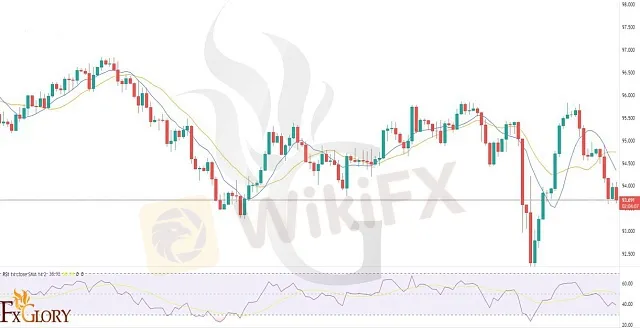简体中文
繁體中文
English
Pусский
日本語
ภาษาไทย
Tiếng Việt
Bahasa Indonesia
Español
हिन्दी
Filippiiniläinen
Français
Deutsch
Português
Türkçe
한국어
العربية
AUDJPY analysis for 03.08.2023
Abstract:On the 4-hour timeframe for AUDJPY, the RSI smoothly shifted below the centerline, signaling a potential bearish bias. Recent price action displayed a sharp bearish movement followed by an equally sharp bullish trend. Furthermore, the shorter moving average crossing below the longer moving average confirms a potential downtrend. Traders should exercise caution and closely monitor price movements for potential selling opportunities.

On the 4-hour timeframe for AUDJPY, the RSI smoothly shifted below the centerline, signaling a potential bearish bias. Recent price action displayed a sharp bearish movement followed by an equally sharp bullish trend. Furthermore, the shorter moving average crossing below the longer moving average confirms a potential downtrend. Traders should exercise caution and closely monitor price movements for potential selling opportunities.
• There is a resistance level at 95.840; followed by resistance at 95.676 and 95.310.
• There is a support level at 92.213. Below, there are 92.785 and 93.244.


Disclaimer:
The views in this article only represent the author's personal views, and do not constitute investment advice on this platform. This platform does not guarantee the accuracy, completeness and timeliness of the information in the article, and will not be liable for any loss caused by the use of or reliance on the information in the article.
Read more

BSP and JICA Renew Partnership to Expand Credit Risk Database for SMEs in the Philippines
On December 11, 2024, a significant milestone was reached in the Philippines' financial sector as the Bangko Sentral ng Pilipinas (BSP) and the Japan International Cooperation Agency (JICA) officially signed the ‘Records of Discussion’ for the second phase of the Credit Risk Database (CRD) project. The ceremony at the BSP headquarters in Manila marked a pivotal moment in widening access to financing for small and medium enterprises (SMEs) across the country.

Market: The Dominant Force in Oil Prices
Recent fluctuations in oil prices have raised concerns, especially with the sharp rise in gasoline prices.

Yen's Weakness Raises Concerns
Recently, the performance of the yen against the dollar has caused some anxiety in the market, especially as the yen weakens, leading investors to worry about its future performance.

How Long Can the Dollar Remain Strong?
The US dollar has continued its strong performance recently, largely driven by the robust US economy and high interest rates. With Trump set to return to the presidency, this bullish trend in the dollar may persist, but whether it can maintain this momentum in the future remains uncertain.
WikiFX Broker
Latest News
How Long Can the Dollar Remain Strong?
Forex Price Trend Prediction! | Come be a New Year Price Winner!
HFM NY Special Offer!
How a Promised RM1.4 Million Return Turned into a Costly Scam
Cinkciarz.pl Under Fire: Frozen Accounts, Missing Funds
First Unfair Trading Case Reported Under South Korea’s Virtual Asset User Protection Act
“Predict and Win” Big Rewards! Join the Contest Now
"Jumped Deposit Scam": New Wave of Financial Fraud in India
South Korean President Yoon Suk Yeol's Arrest Shakes Markets
Titanium Capital LLC Ponzi Scheme: Henry Abdo Admits Fraud, Impacting Over 200 Investors
Currency Calculator






